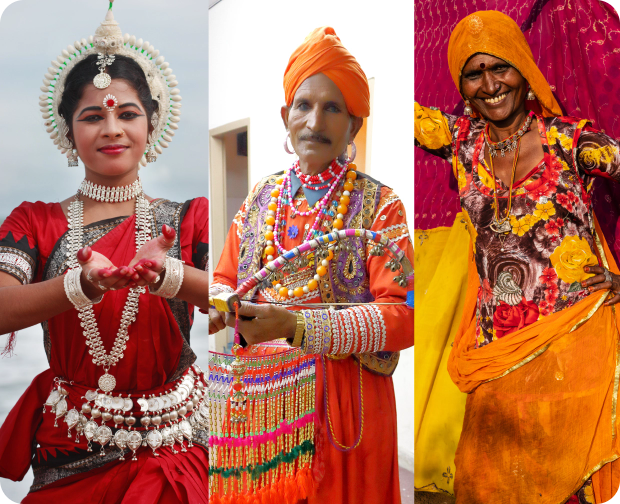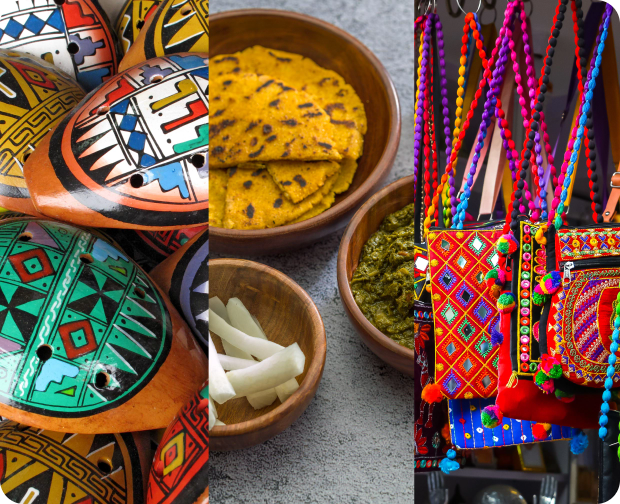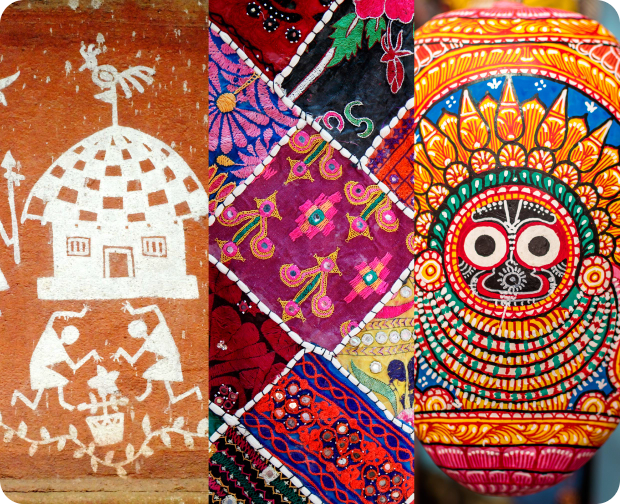Experience the best of India's folk & tribal culture
- Live Performances
- Interactive workshops
- Film festival
- Artisan market
- Food stalls
24th – 26th January 2025, 10 AM – 8:30 PM
Karnataka Chitrakala Parishath, Bengaluru
Step into a world where stories of India’s tribal and folk culture come alive in every sound, move, color, fabric and taste. Kala Dhwani reconnects you with India's rich heritage. Dance, sing, and paint with those who preserve our history.
Whether you're a cultural enthusiast, curious explorer, or seeking a memorable experience, Kala Dhwani has something for everyone. Join us in celebrating India's legacy.

Celebrate the tribal and folk richness of Karnataka, Odisha, Punjab, Rajasthan, and West Bengal.

Enjoy free performances by city favorites Raghu Dixit, Vid Kumaresh, and Rajesh Vaidya.

Savor local cuisines and explore handmade tribal merchandise.

Experience dance and music that bring various art forms to life.
India's tribal and folk art traditions are deeply connected to nature, local deities, vibrant festivals, and captivating narratives. These art forms, passed down through generations, offer a glimpse into India's diverse cultural heritage.
Infosys Foundation is committed to preserving India's cultural heritage, supporting artists, and bringing their art closer to people. Decades of non-representation have left tribal and folk art without an audience. With the aim of restoring India's indigenous art forms, Infosys Foundation presents Kala Dhwani: Echoes of India’s Art. Together with Bharatiya Vidya Bhavan, taking our 25+ years of collaboration further ahead, we bring you India's incredible tribal and folk heritage under one roof in Namma Bengaluru.
The folk and tribal culture of Karnataka has evolved over centuries, reflecting the region's history, geography, and diverse communities. In ancient times, these traditions emerged from animistic practices, nature worship, and rituals dedicated to local deities. With early tribes expressing their connection to nature through oral traditions, songs, dances, and symbolic art, Karnataka's society evolved and developed a unique cultural expression tied to their ways of life. Tribal groups like the Soligas, Koragas, Siddis, and Hakki Pikkis blended mythology, history, and social themes with different storytelling mediums preserving their historical journey from ancient to modern Karnataka.
Developed over thousands of years, the folk and tribal culture of Odisha is deeply influenced by its indigenous communities and their strong bond with nature. With tribes such as the Santals, Bondas, Juangs, Saoras, and Mundas worshipping natural elements, ancestors and spirits; art and culture in Odisha's tribal societies revolved around rituals, agricultural cycles, and festivals. Practices like the Saora Ritualistic Dance, Karma Dance, and Chhau Dance emerged, combining dance, music, and storytelling. Odisha's tribal and folk cultures have adapted over time, preserving their historical essence while evolving with societal changes.
Influenced by Vedic traditions, Buddhism and later, Sikhism, Punjab’s folk and tribal traditions reflect its rural rhythms that evolved over time. Songs like Tappe, Boliyan, and Gidda celebrated harvests, weddings, and community events, while dances such as Bhangra and Gidda became integral to seasonal festivals like Baisakhi. Folk songs and traditions often blended with spiritual themes, as seen in Sufi poetry by Baba Farid and the incorporation of folk melodies into Gurbani. During the medieval era, Punjab’s position as a cultural crossroads brought Persian and Central Asian influences that enriched its folk traditions. However, Punjab retained its historical essence and remains a testament to the resilience and communal spirit of its people, deeply rooted in its agrarian and tribal heritage.
The folk and tribal traditions of Rajasthan is shaped by the region’s arid landscape, warrior culture, and rich heritage. Rajasthan's tribal communities were among the earliest inhabitants of the region including the Bhil and Meena tribes, who used folk dances like Ghoomar and Terahtali to celebrate communal events, while oral traditions such as Panihari songs conveyed tales of love and hardship in the desert. Over time, these communities developed unique traditions of music, dance, and storytelling which have continued to evolve, retaining their historical essence and distinct identity amidst changing times.
West Bengal’s natural surroundings and socio-political history has deeply influenced its tribal and folk culture which had agriculture, hunting, and the forest forming the foundation of their cultural and religious activities. Tribal communities such as the Santals, Oraons, Mundas, and Bauris developed rich oral traditions while folk art forms like Baul songs, Jhumur dance, and Patachitra painting emerged as vital cultural expressions, blending spiritual and social themes. During the medieval period, folk traditions flourished alongside classical forms, supported by local rulers and religious movements like the Bhakti tradition. Over the years, West Bengal's folk and tribal culture adapted and retained its historical core and till date remains as a reflection of its tribal roots, rural heritage, and evolving socio-religious influences.
